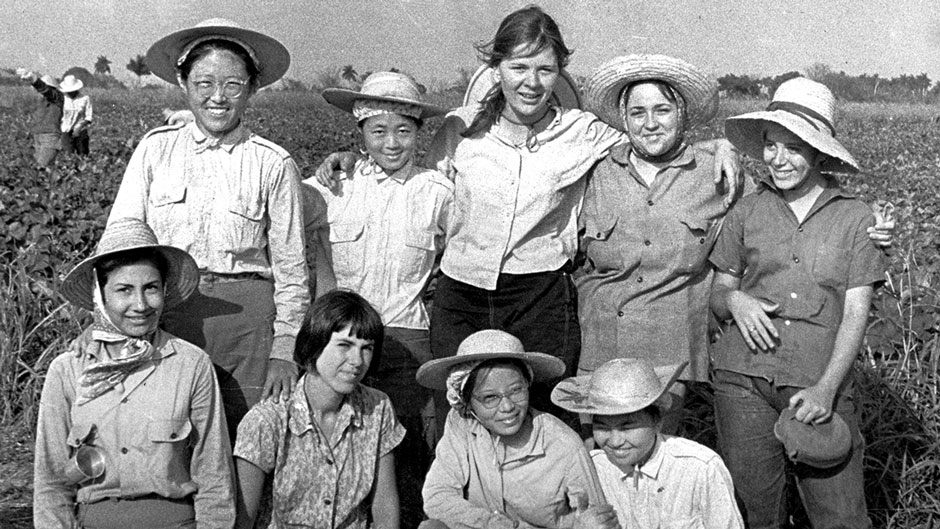Anna Veltfort’s life has a unique place in Cuban history.
Born in Germany, Veltfort—whose nickname is Connie—was brought to the United States as a child and then to Cuba in 1962.
At a time during which many were fleeing the island because of the rise of Castro’s Communist regime, Veltfort’s stepfather, enamored with the promises of the Socialist Revolution, decided to immigrate to the island. He was a Communist and a veteran of the Spanish Civil War.
Veltfort attended the Instituto del Vedado and later studied art history at the University of Havana, graduating in 1972. She currently lives in New York where she works as an illustrator.
“We went filled with idealism and great enthusiasm for what my stepfather imagined as a new utopia become reality,” recalled Veltfort. “I identified with the idealized goals of racial equality, of justice and access to education and housing for all but saw and felt the injustices suffered by anyone who did not conform to the norms demanded of every citizen. The conflicts between my ideals and my experiences became more and more difficult to navigate.”
Veltfort had begun a same-sex relationship during her high school years and soon realized that the government did not consider gay people acceptable members of a revolutionary society. The government’s campaign to stigmatize gay people and equate them with political “counterrevolutionaries” was painful and frightening during her years at the University of Havana.
The artist said that even though she navigated a complicated daily life, it was one that she valued. “I enjoyed the exhilarating camaraderie of my classmates in our trips to do agricultural work and carry out research projects in the countryside,” she noted. “I loved my friends. I fell in love with Cuban culture, Havana nightlife, the music of the famous cabarets, the beauty of the city, the ocean breeze, and the waves by the seaside promenade, the Malecón.”
Her disillusionment did not come in a day.
“The treatment of gay people, especially starting in 1965 when my university was bombarded with antigay rhetoric by the government and by the UJC (the Young Communist Union) was certainly the most obvious and painful cause for questioning the Revolution and its trajectory while I lived there during those 10 years,” she explained.
Veltfort returned to the U.S. in 1972. In subsequent years, her disillusionment grew as she saw “the ever increasing militarization of daily life and of the life of the country; the Cuban government’s rejection of Glasnost (the political liberalization policies of Gorbachov in the Soviet Union); the show trial and execution of General Ochoa; and the deliberate sinking of the Tugboat “13 de marzo” in July 1994, with 70 people aboard who had hijacked the boat in their attempt to flee Cuba—37 men, women, and children drowned,” she said.
“I had come from Cuba back to the U.S. with a large number of Cuban materials, including magazines, clippings, cartoons, and government screeds that declared war on gay people in the university and all over Cuba during the 1960s,” she pointed out. In 2007, the Cuban government presented the three worst government officials—who had carried out the purges and the witch hunts against students, theater people, artists, writers, and all cultural workers in the 1960s—as heroes and as distinguished, respected representatives of Cuban Cultural leadership, according to Veltfort.
She wanted to counter the government's attempt to erase the repression of the 1960s.
Veltfort started a blog called “El Archivo de Connie,” which circulated widely among Cuban scholars and people interested in Cuba. The blog included her reflections on topics as wide as Cuban theater, the arts, architecture, political discourse, and student life. Her blog included magazines, newspaper clippings, and photos.
The artist recently donated her archive to the University of Miami Libraries Cuban Heritage Collection.
“Anna Veltfort's collection includes a variety of materials. Vintage posters, LPs, publications, and other ephemera and their respective content intersect with a wide range of research areas such as the visual arts, identity, Queer studies, cultural politics, theater, creative writing, etc. that serve as important resources to students, faculty, and scholars interested in learning more about early Revolutionary culture,” said Elizabeth Cerejido, director and Esperanza Bravo de Varona Chair of the Cuban Heritage Collection. “Veltfort's archive, which is rich in content and material, sheds light on the visual culture of the late 1960s and 1970s Cuba,” she added.
On Thursday, June 10, at 4 p.m., Veltfort will discuss her work and her contributions to understanding life in Cuba in the ’60s and ’70s during the virtual event “El Archivo de Connie and Other Stories—A Conversation with Anna Veltfort.” Cerejido will offer opening remarks during the event, which is presented in partnership with the Department of Modern Languages and Literatures.
Other moderators will include Lillian Manzor, associate professor, Department of Modern Languages and Literatures; Yolanda Martinez-San Miguel, professor and chair of the Department of Modern Languages and Literatures; and Martin Tsang, Cuban Heritage Collection librarian and curator of Latin American Collections.
Register for the event.

